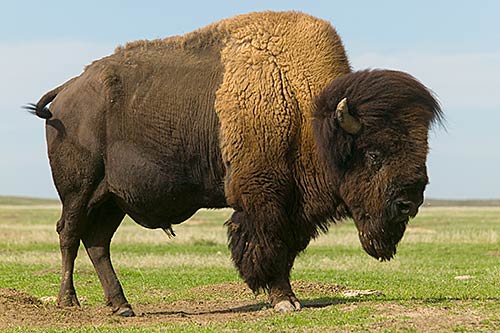Bison Latest Pictures
 The American bison and the European wisent are good swimmers and are the largest terrestrial animals in North America and Europe. Bison are nomadic grazers and travel in herds, except for the non-dominant bulls, which travel alone or in small groups during most of the year. American bison are known for living in the Great Plains. Both species were hunted close to extinction during the 19th and 20th centuries but have since rebounded. there are a number of physical and behavioural differences between the American and European bison. The American species has 15 ribs, while the European bison has 14. The American bison has four lumbar vertebrae, while the European has five. Adult American bison are not as rangy in build, and have shorter legs. American bison tend to graze more, and browse less than their European cousins .
The American bison and the European wisent are good swimmers and are the largest terrestrial animals in North America and Europe. Bison are nomadic grazers and travel in herds, except for the non-dominant bulls, which travel alone or in small groups during most of the year. American bison are known for living in the Great Plains. Both species were hunted close to extinction during the 19th and 20th centuries but have since rebounded. there are a number of physical and behavioural differences between the American and European bison. The American species has 15 ribs, while the European bison has 14. The American bison has four lumbar vertebrae, while the European has five. Adult American bison are not as rangy in build, and have shorter legs. American bison tend to graze more, and browse less than their European cousins . The body of the American bison is typically hairier, though its tail has less hair than that of the European bison. The horns of the European bison point through the plane of their faces, making them more adept at fighting through the interlocking of horns in the same manner as domestic cattle, unlike the American bison which favours butting.
The body of the American bison is typically hairier, though its tail has less hair than that of the European bison. The horns of the European bison point through the plane of their faces, making them more adept at fighting through the interlocking of horns in the same manner as domestic cattle, unlike the American bison which favours butting. A bison wallow is a shallow depression in the soil, either wet or dry. Bison roll in these depressions, covering themselves with mud or dust. Possible explanations suggested for wallowing behavior include grooming behavior associated with moulting, male-male interaction (typically rutting behavior), social behavior for group cohesion, play behavior, relief from skin irritation due to biting insects, reduction of ectoparasite load (ticks and lice), and thermoregulation.
A bison wallow is a shallow depression in the soil, either wet or dry. Bison roll in these depressions, covering themselves with mud or dust. Possible explanations suggested for wallowing behavior include grooming behavior associated with moulting, male-male interaction (typically rutting behavior), social behavior for group cohesion, play behavior, relief from skin irritation due to biting insects, reduction of ectoparasite load (ticks and lice), and thermoregulation.
Their most obvious weapons are the horns borne by both males and females. But their massive heads can be used as battering rams, effectively using the momentum produced by 2,000 pounds (900 kg) moving at 30 mph (50 km/h). The hind legs can also be used to kill or maim with devastating effect. At the time bison ran wild, they were rated second only to the Alaska brown bear as a potential killer, more dangerous than the grizzly bear. In the words of early naturalists, they were a dangerous, savage animal that feared no other animal and in prime condition could best any foe.
The rutting, or mating, season lasts from June through September with peak activity in July and August.














0 comments:
Post a Comment